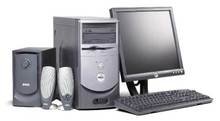Intel made two fateful decisions in 2004.
- It committed to parallel processing, as we’ve discussed.
- It committed to low power designs.
So why, two years later, is anyone selling desktop PCs?
I can understand plugging in a server. If each blade in a server is running at 6 volts, then if you have at least 20 (and that’s a nice low figure) you plug it in the wall. If you’re running a major server farm, maybe you have to use one of those 240 volt dryer plugs.
But everything else should be a stepper. Everything else should be low power.
The difference between a "desktop" and a "laptop" computer should not be its power supply. It should be modularity, expandability. You should be able to plug a lot of things into a "desktop" machine, and your power supply should adapt on-the-fly to the load.
At best a desktop should basically be a docking module.
Instead I’ve still got this boat anchor box under my desk, I’ve got
separate plugs for the speakers and screen, and it’s a separate
UPS-power box that handles the integration. Yet that’s the only real
purpose I can see for a desktop — power management. When is APC going to bring out a PC?
Mainly I want this low power revolution to start rolling faster. Now
that the chip companies have got the message out, the PC makers should
be following suit with new designs that make sense. And we should start
seeing savings on our power bills as well.












I don’t see how all of the things you mentioned fit together. If you want lower overall power consumption, it is not only up to the PC makers but also the peripheral makers. Dell doesn’t make video cards or hard drives so how can they have ultimate control over the power consumption of their box, especially if it is a user upgradeable system? Power supplies are always going to run most efficiently close to full load, so what you want is a more complicated power supply that is actually multiple units in the same box with a controler to turn them on and off as needed. You will not be able to go with anything so sophisticated without raising the PC price. Is electricity expensive enough to justify this? Meanwhile, new processors are certainly more energy efficient, but are they any less energy hungry? My new Core 2 Duo kicks my old first-generation P4 in the ass in terms of computations/W, but it is capable of so many more computations that it actually uses more Watts than that old processor even at idle. Why PCs don’t have an auxilary power socket or two (for things like monitors, speakers, printers, and external drives) is a very good question. Consumer electronics items have been doing this for years and it is very useful. What would be even better though, is something like USB but with a high power output — thus you only need the one cable. There is a little known standard called PoweredUSB which is actually just what I described. Perhaps it will come to the home PC and peripherals in the near future.
I don’t see how all of the things you mentioned fit together. If you want lower overall power consumption, it is not only up to the PC makers but also the peripheral makers. Dell doesn’t make video cards or hard drives so how can they have ultimate control over the power consumption of their box, especially if it is a user upgradeable system? Power supplies are always going to run most efficiently close to full load, so what you want is a more complicated power supply that is actually multiple units in the same box with a controler to turn them on and off as needed. You will not be able to go with anything so sophisticated without raising the PC price. Is electricity expensive enough to justify this? Meanwhile, new processors are certainly more energy efficient, but are they any less energy hungry? My new Core 2 Duo kicks my old first-generation P4 in the ass in terms of computations/W, but it is capable of so many more computations that it actually uses more Watts than that old processor even at idle. Why PCs don’t have an auxilary power socket or two (for things like monitors, speakers, printers, and external drives) is a very good question. Consumer electronics items have been doing this for years and it is very useful. What would be even better though, is something like USB but with a high power output — thus you only need the one cable. There is a little known standard called PoweredUSB which is actually just what I described. Perhaps it will come to the home PC and peripherals in the near future.